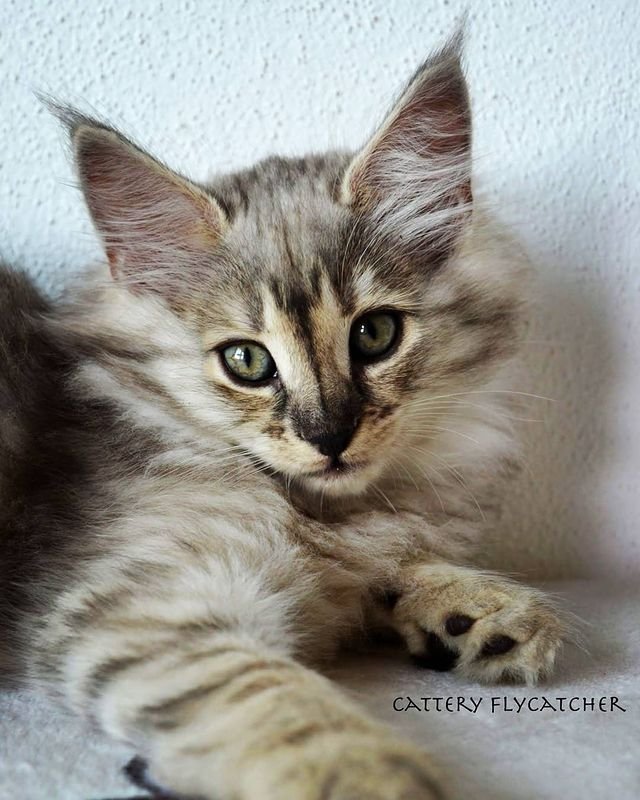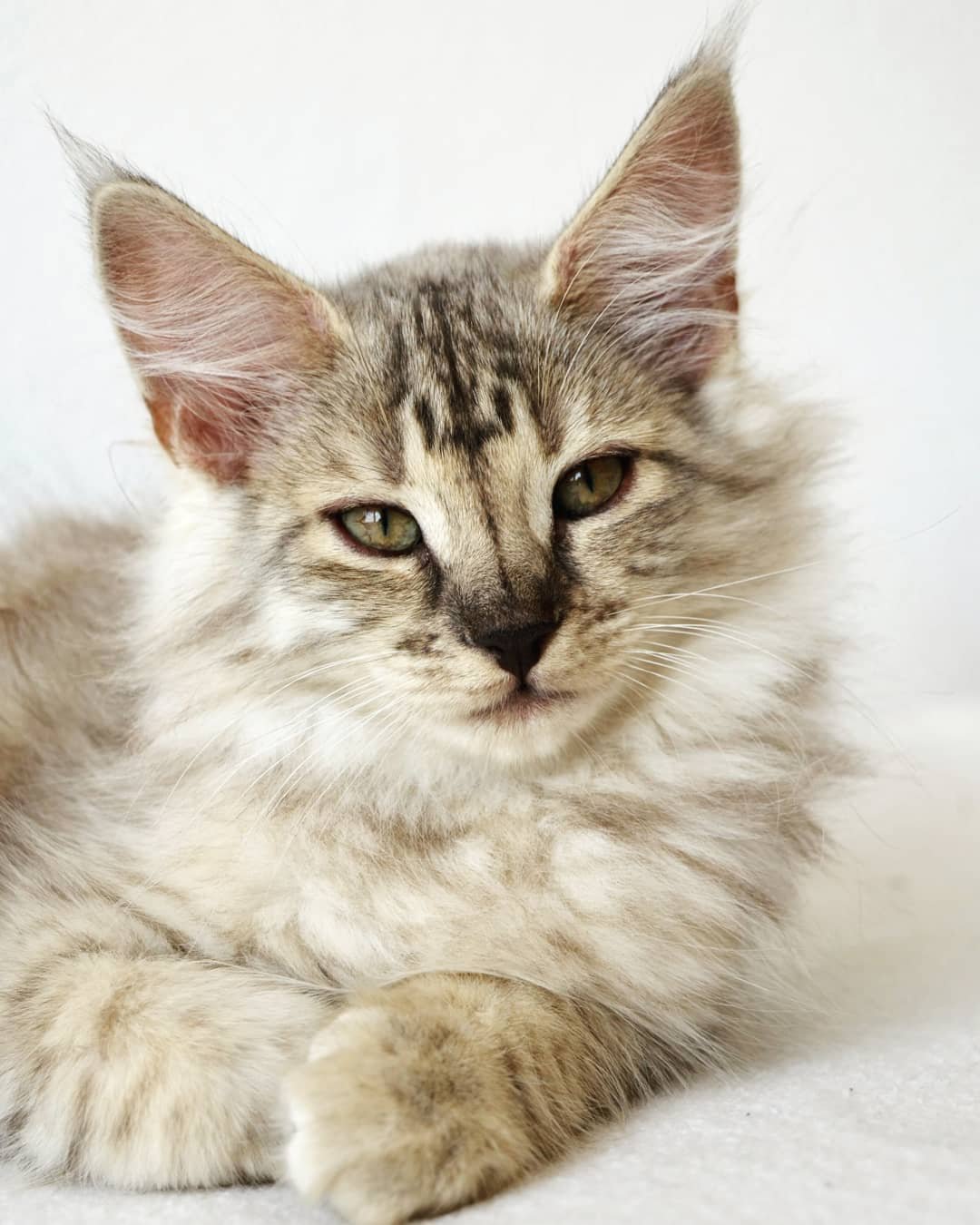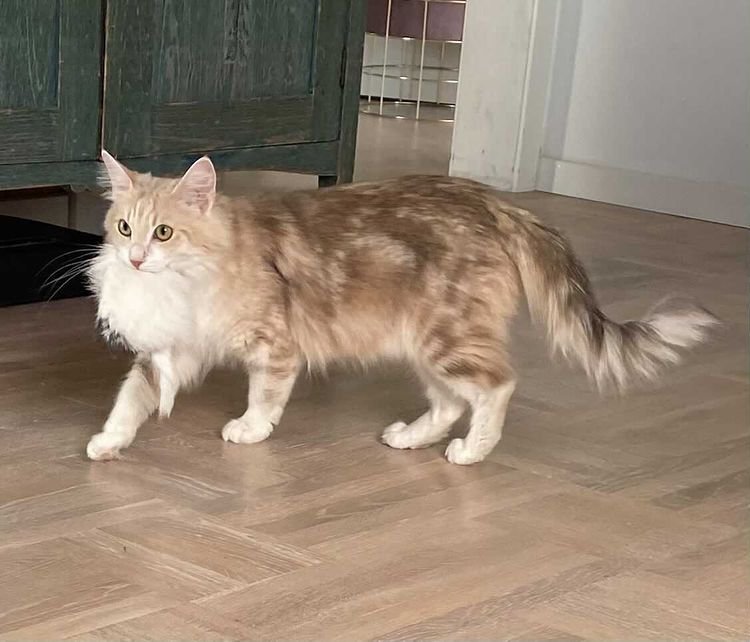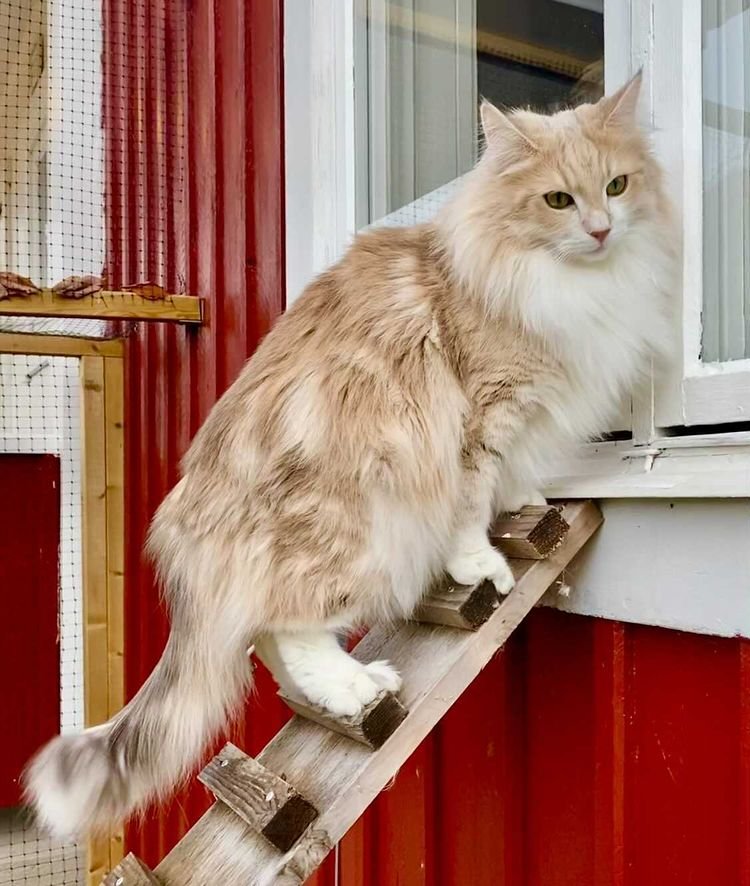The amber color: A Norwegian Forest cat particularity!
In a previous series of articles, I presented all the basic cat coat colors. It is now time to cover the breed-specific colors. I will start with not just any color, but the one of my cats Néline and Praline: the amber color. As we will see in the article, amber is specific to Norwegian Forest cats and I will explain what are its properties, its history, and the genetics that make it happen.
Note: Before reading this article, I recommend you to read the articles of the first series on basic cat coat colors: some of the genetic explanations will be useful to understand this article.
The previous articles in the series cover:
What is amber?
Amber is a coat effect that transforms black hair into yellow hair, which gives amber cats generally a warm golden color. The effect of amber will depend on the base color: black amber cats generally have a hot red color, while blue amber (also called light amber) often have a more peach/cream color.
The amber effect applies only to the hair and not the skin: a black amber cat will have dark paw pads.
Amber solid cats (aka non-agouti) have a very particular look as they appear tabby but with a dark nose. Because of this, amber solid cats are often called black noses.
Here are the descriptions of the 4 main variations of the amber color.
A black amber blotched tabby from @kweli_and_kivu
Black amber tabby
At birth, black amber tabby cats are born with black tabby markings and pink paw pads. They are similar to warmly-colored brown tabby cats.
They progressively get lighter and more golden as they grow up. This evolution generally takes around 6 months, but some slower changes still occur in the following years. The black hairs remain only on some parts of the body like the paws, the back, the tail, or the top of the ears.
They have dark eye rims and a pink nose. It’s interesting to note that–contrary to black tabby cats–, black amber tabby cats don’t have a dark border around their nose.
After birth, their paw pads turn from pink to black: this is an easy way to differentiate them from red cats, and it also shows that they are genetically black.
The evolution of Néline, a black amber blotched tabby and white
Blue amber tabby
At birth, blue amber tabby (also called light amber tabby) are born with blue tabby markings and pink paw pads.
Like for the black amber cats, the color change is progressive and they get a pink-cream hue. They also keep some remaining blue hairs in the same areas as the black amber tabby.
As they grow up, their paw pads get a dark grey coloration.
It seems that blue amber cats have a slower evolution than black amber, and often have more remaining blue hairs.
A blue amber blotched tabby from birth to 9 months old from @iconic_nfo
Black amber
Black amber cats are often just called amber, amber solid, or black nose. At birth, they are almost identical to black tabby cats, as they have dark paw pads.
The color between the tabby markings gets lighter and warmer as they grow up, taking an apricot color. The dark tabby markings sometimes remain black and sometimes get clearer.
The nose, paw pads, and eye rims remain black.
There are a lot of variations between amber solid cats, some keep a very cold shade while some others have a hotter color. This is likely due to the influence of rufism.
Evolution of an amber solid from @expecto_pawtronum
Blue amber
At birth, blue amber cats are close to identical to blue tabby cats, as they have dark grey paw pads.
As they grow up, the color between the markings gets a pink cream hue. The dark markings often remain quite blue but after a few years, they can get clearer.
The nose, paw pads, and eye rims remain dark grey to lavender.
Blue amber cats seem to be the slowest ones to evolve and often remain quite dark.
It seems that blue amber smoke cats often don’t evolve as much and keep a cold and dark coloring.
A blue amber solid kitten from @expecto_pawtronum
Of course, in addition to all these variations, there can be white, tortie and silver, or smoke.
To summarize, the 5 main characteristics of the amber color are:
Black becomes apricot and blue becomes pink cream, but dark hairs remain on the back, tail, and ears.
Tabby markings become clearer and solid cats have strong ghost markings.
The nose is pink in tabby cats, and dark in solid cats.
Paw pads are dark.
Eye rims are dark.
A blue amber smoke from Château Boréal
Hypothetical ambers
As several colors aren’t present in the Norwegian breed, several theoretical variations of the amber are unknown, such as chocolate amber, or amber point.
The history of the amber color
The history of the amber is quite recent: it started in 1992 with the birth of two Norwegian forest cat brothers in Sweden, which were identified as blue mackerel tabby and black blotched tabby. However, their color was particular, as between the blue stripes the color was peach and between the black stripes it was apricot. The color kept evolving and judges initially decided that they were golden tabby. They have then judged again as lilac tabby and chocolate tabby. However, all these colors are forbidden in the Norwegian standard and are normally absent from the breed.
Later on, mainly in Sweden but also in Germany, other kittens with these unknown colors were born and were designed as "X-color" at that time.
Evolution of an amber smoke from de @simone.flycatcher
The X-color created a lot of debate among the Norwegian forest cat breeders, some arguing that Norwegians got mixed with other breeds and were cinnamon or fawn-colored.
In 2003, breeders made “test matings” which showed that it couldn’t be cinnamon or chocolate alleles as the cats were genetically black.
Following these test matings, the color was officially recognized by the Fife in 2005 and was called amber.
The gene responsible for the amber color was finally identified in 2009 by Dr. Marc Peterschmitt. Following this genetic discovery, the amber color was officially recognized by most cat fancies and “allowed” in the Norwegian breed.
All amber cats are the descendants of a single cat named N*Kløfterhagens Babuschka, which was very likely an amber carrier. Because of inbreeding, the amber gene was revealed. It’s not known if she had a spontaneous mutation or if she inherited it.
A blue amber blotched tabby in different lightning from @iconic_nfo
Genetic
The amber color is caused by the gene called Extension which is coding the melanocortin-1-receptor, which is essential to produce black pigments on the hair. To put it simply, in the case of amber cats, this receptor is mutated and, so, it can’t produce black pigments, producing yellow pigments instead.
The dominant allele "E" gives black pigments and the recessive allele "e" gives yellow pigments. So, an amber cat needs to be homozygous for the allele e (e/e). Non-amber cats are either E/E or E/e.
Cats having one copy of the e locus (E/e) are called amber carriers, as they have a 50% chance to transmit the amber gene to their offspring. Empirically, it seems that amber carriers generally have a warm coat color.
Finally, to explain the phenomena of the black nose in amber solid cats, the gene extension is epistatic over the agouti gene. This means that–even if a cat is a/a (aka solid or non-tabby)–the expression of this gene will be blocked by the amber one. That’s why amber solid cats have ghost tabby markings, even if they are not tabby.
The orange gene is epistatic to the amber, meaning that on a red cat the amber won’t have any effect. However, it seems that red amber cats are light-colored looking almost like a red silver tabby.
It’s not understood why the color is evolutive, and why kittens can still produce black hairs.
The evolution of Praline, a black tortie amber smoke
Fun fact
Two other mammals have a similar mutation of the extension gene: red-haired humans and chestnut horses.
Can you have an amber cat that is not a Norwegian Forest cat?
Technically yes: Norwegian Forest cats are genetically the same species as domestic cats, with the only difference being that they have a pedigree showing their ancestors. However, to my knowledge, the amber mutation happened only in the Norwegian Forest cat breed and all amber cats are descendants of the same Norwegian cat. So, if Norwegian forest cats would be bred with domestic cats and the gene selected (as it's recessive and not present in the domestic cat population it would require selective breeding to have domestic amber cats) domestic cats could be amber. It could also happen if the mutation appears randomly in the domestic cat population.
I have never heard or seen it happening, but it may happen in the future.
A blue amber tabby and white, and a black amber tabby and white from @live_with_nor
To summarize, amber is a recessive gene that transforms black pigment into yellow pigment. This color is relatively new as it appeared in 1992 and is present only in the Norwegian Forest cat breed. One of the particularities of this color is that it is evolutive, and the coat of amber cats will keep changing until several years of life.
Sources
Peterschmitt M, Grain F, Arnaud B, Deléage G, Lambert V. Mutation in the melanocortin 1 receptor is associated with amber colour in the Norwegian Forest Cat. Anim Genet. 2009;40(4):547-552. doi:10.1111/j.1365-2052.2009.01864.x
Marc Peterschmitt, L’ambre chez le chat des forêts norvégiennes, un mystère résolu (thèse de doctorat vétérinaire), Lyon, Université Claude-Bernard - Lyon I, 2009
Other readings
Recognize an amber solid and light amber solid kitten
Recognize a light amber smoke from an amber smoke























